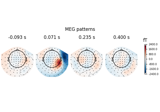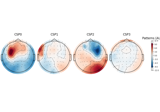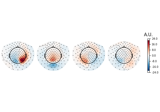mne.decoding.SpatialFilter#
- class mne.decoding.SpatialFilter(info, filters, *, evals=None, patterns=None, patterns_method='pinv')[source]#
Container for spatial filter weights (evecs) and patterns.
Warning
For MNE-Python decoding classes, this container should be instantiated with
mne.decoding.get_spatial_filter_from_estimator. Direct instantiation with external spatial filters is possible at your own risk.This object is obtained either by generalized eigendecomposition (GED) algorithms such as
mne.decoding.CSP,mne.decoding.SPoC,mne.decoding.SSD,mne.decoding.XdawnTransformeror bymne.decoding.LinearModel, wrapping linear models like SVM or Logit. The object stores the filters that projects sensor data to a reduced component space, and the corresponding patterns (obtained by pseudoinverse in GED case or Haufe’s trick in case ofmne.decoding.LinearModel). It can also be directly initialized using filters from other transformers (e.g. PyRiemann), but make sure that the dimensions match.- Parameters:
- infoinstance of
Info The measurement info containing channel topography.
- filters
ndarray, shape ((n_classes), n_components, n_channels) The spatial filters (transposed eigenvectors of the decomposition).
- evals
ndarray, shape ((n_classes), n_components) |None The eigenvalues of the decomposition. Defaults to
None.- patterns
ndarray, shape ((n_classes), n_components, n_channels) |None The patterns of the decomposition. If None, they will be computed from the filters using pseudoinverse. Defaults to
None.- patterns_method
str The method used to compute the patterns. Can be
'pinv'or'haufe'. Ifpatternsis None, it will be set to'pinv'. Defaults to'pinv'.
- infoinstance of
- Attributes:
- infoinstance of
Info The measurement info.
- filters
ndarray, shape (n_components, n_channels) The spatial filters (unmixing matrix). Applying these filters to the data gives the component time series.
- patterns
ndarray, shape (n_components, n_channels) The spatial patterns (mixing matrix/forward model). These represent the scalp topography of each component.
- evals
ndarray, shape (n_components,) The eigenvalues associated with each component.
- patterns_method
str The method used to compute the patterns from the filters.
- infoinstance of
Methods
plot_filters([components, tmin, ch_type, ...])Plot topographic maps of model filters.
plot_patterns([components, tmin, ch_type, ...])Plot topographic maps of model patterns.
plot_scree([title, add_cumul_evals, axes, show])Plot scree for GED eigenvalues.
See also
Notes
The spatial filters and patterns are stored with shape
(n_components, n_channels).Filters and patterns are related by the following equation:
\[\mathbf{A} = \mathbf{W}^{-1}\]where \(\mathbf{A}\) is the matrix of patterns (the mixing matrix) and \(\mathbf{W}\) is the matrix of filters (the unmixing matrix).
For a detailed discussion on the difference between filters and patterns for GED see [1] and for linear models in general see [2].
New in v1.11.
References
- plot_filters(components=None, tmin=None, *, ch_type=None, scalings=None, sensors=True, show_names=False, mask=None, mask_params=None, contours=6, outlines='head', sphere=None, image_interp='cubic', extrapolate='auto', border='mean', res=64, size=1, cmap='RdBu_r', vlim=(None, None), cnorm=None, colorbar=True, cbar_fmt='%3.1f', units=None, axes=None, name_format='Filter%01d', nrows=1, ncols='auto', show=True)[source]#
Plot topographic maps of model filters.
- Parameters:
- components
float|arrayoffloat| ‘auto’ |None Indices of filters to plot. If “auto”, the number of
axesdetermines the amount of filters. If None, all filters will be plotted. Defaults to None.- tmin
float|None In case filters are distributed temporally, this can be used to align them with times and frequency. Use
epochs.tmin, for example. Defaults to None.- ch_type‘mag’ | ‘grad’ | ‘planar1’ | ‘planar2’ | ‘eeg’ |
None The channel type to plot. For
'grad', the gradiometers are collected in pairs and the RMS for each pair is plotted. IfNonethe first available channel type from order shown above is used. Defaults toNone.- scalings
dict|float|None The scalings of the channel types to be applied for plotting. If None, defaults to
dict(eeg=1e6, grad=1e13, mag=1e15).- sensorsbool |
str Whether to add markers for sensor locations. If
str, should be a valid matplotlib format string (e.g.,'r+'for red plusses, see the Notes section ofplot()). IfTrue(the default), black circles will be used.- show_namesbool |
callable() If
True, show channel names next to each sensor marker. If callable, channel names will be formatted using the callable; e.g., to delete the prefix ‘MEG ‘ from all channel names, pass the functionlambda x: x.replace('MEG ', ''). Ifmaskis notNone, only non-masked sensor names will be shown.- mask
ndarrayof bool, shape (n_channels, n_times) |None Array indicating channel-time combinations to highlight with a distinct plotting style (useful for, e.g. marking which channels at which times a statistical test of the data reaches significance). Array elements set to
Truewill be plotted with the parameters given inmask_params. Defaults toNone, equivalent to an array of allFalseelements.- mask_params
dict|None Additional plotting parameters for plotting significant sensors. Default (None) equals:
dict(marker='o', markerfacecolor='w', markeredgecolor='k', linewidth=0, markersize=4)
- contours
int| array_like The number of contour lines to draw. If
0, no contours will be drawn. If a positive integer, that number of contour levels are chosen using the matplotlib tick locator (may sometimes be inaccurate, use array for accuracy). If array-like, the array values are used as the contour levels. The values should be in µV for EEG, fT for magnetometers and fT/m for gradiometers. Ifcolorbar=True, the colorbar will have ticks corresponding to the contour levels. Default is6.- outlines‘head’ |
dict|None The outlines to be drawn. If ‘head’, the default head scheme will be drawn. If dict, each key refers to a tuple of x and y positions, the values in ‘mask_pos’ will serve as image mask. Alternatively, a matplotlib patch object can be passed for advanced masking options, either directly or as a function that returns patches (required for multi-axis plots). If None, nothing will be drawn. Defaults to ‘head’.
- sphere
float| array_like offloat| instance ofConductorModel|str|listofstr|None The sphere parameters to use for the head outline. Can be array-like of shape (4,) to give the X/Y/Z origin and radius in meters, or a single float to give just the radius (origin assumed 0, 0, 0). Can also be an instance of a spherical
ConductorModelto use the origin and radius from that object. Can also be astr, in which case:'auto': the sphere is fit to external digitization points first, and to external + EEG digitization points if the former fails.'eeglab': the head circle is defined by EEG electrodes'Fpz','Oz','T7', and'T8'(if'Fpz'is not present, it will be approximated from the coordinates of'Oz').'extra': the sphere is fit to external digitization points.'eeg': the sphere is fit to EEG digitization points.'cardinal': the sphere is fit to cardinal digitization points.'hpi': the sphere is fit to HPI coil digitization points.
Can also be a list of
str, in which case the sphere is fit to the specified digitization points, which can be any combination of'extra','eeg','cardinal', and'hpi', as specified above.None(the default) is equivalent to'auto'when enough extra digitization points are available, and (0, 0, 0, 0.095) otherwise.New in v0.20.
Changed in version 1.1: Added
'eeglab'option.Changed in version 1.11: Added
'extra','eeg','cardinal','hpi'and list ofstroptions.- image_interp
str The image interpolation to be used. Options are
'cubic'(default) to usescipy.interpolate.CloughTocher2DInterpolator,'nearest'to usescipy.spatial.Voronoior'linear'to usescipy.interpolate.LinearNDInterpolator.- extrapolate
str Options:
'box'Extrapolate to four points placed to form a square encompassing all data points, where each side of the square is three times the range of the data in the respective dimension.
'local'(default for MEG sensors)Extrapolate only to nearby points (approximately to points closer than median inter-electrode distance). This will also set the mask to be polygonal based on the convex hull of the sensors.
'head'(default for non-MEG sensors)Extrapolate out to the edges of the clipping circle. This will be on the head circle when the sensors are contained within the head circle, but it can extend beyond the head when sensors are plotted outside the head circle.
- border
float| ‘mean’ Value to extrapolate to on the topomap borders. If
'mean'(default), then each extrapolated point has the average value of its neighbours.- res
int The resolution of the topomap image (number of pixels along each side).
- size
float Side length of each subplot in inches.
- cmapmatplotlib colormap | (colormap, bool) | ‘interactive’ |
None Colormap to use. If
tuple, the first value indicates the colormap to use and the second value is a boolean defining interactivity. In interactive mode the colors are adjustable by clicking and dragging the colorbar with left and right mouse button. Left mouse button moves the scale up and down and right mouse button adjusts the range. Hitting space bar resets the range. Up and down arrows can be used to change the colormap. IfNone,'Reds'is used for data that is either all-positive or all-negative, and'RdBu_r'is used otherwise.'interactive'is equivalent to(None, True). Defaults toNone.Warning
Interactive mode works smoothly only for a small amount of topomaps. Interactive mode is disabled by default for more than 2 topomaps.
- vlim
tupleof length 2 | “joint” Lower and upper bounds of the colormap, typically a numeric value in the same units as the data. Elements of the
tuplemay also be callable functions which take in aNumPy arrayand return a scalar.If both entries are
None, the bounds are set at ± the maximum absolute value of the data (yielding a colormap with midpoint at 0), or(0, max(abs(data)))if the (possibly baselined) data are all-positive. ProvidingNonefor just one entry will set the corresponding boundary at the min/max of the data. Ifvlim="joint", will compute the colormap limits jointly across all topomaps of the same channel type (instead of separately for each topomap), using the min/max of the data for that channel type. Defaults to(None, None).- cnorm
matplotlib.colors.Normalize|None How to normalize the colormap. If
None, standard linear normalization is performed. If notNone,vminandvmaxwill be ignored. See Matplotlib docs for more details on colormap normalization, and the ERDs example for an example of its use.- colorbarbool
Plot a colorbar in the rightmost column of the figure.
- cbar_fmt
str Formatting string for colorbar tick labels. See Format Specification Mini-Language for details.
- units
dict|str|None The units to use for the colorbar label. Ignored if
colorbar=False. IfNoneandscalings=Nonethe unit is automatically determined, otherwise the label will be “AU” indicating arbitrary units. Default isNone.- axesinstance of
Axes|listofAxes|None The axes to plot into. If
None, a newFigurewill be created with the correct number of axes. IfAxesare provided (either as a single instance or alistof axes), the number of axes provided must match the number oftimesprovided (unlesstimesisNone). Default isNone.- name_format
str String format for topomap values. Defaults to
'Filter%01d'.- nrows, ncols
int| ‘auto’ The number of rows and columns of topographies to plot. If either
nrowsorncolsis'auto', the necessary number will be inferred. Defaults tonrows=1, ncols='auto'.- showbool
Show the figure if
True.
- components
- Returns:
- figinstance of
matplotlib.figure.Figure The figure.
- figinstance of
Examples using
plot_filters:
Linear classifier on sensor data with plot patterns and filters
Linear classifier on sensor data with plot patterns and filters
- plot_patterns(components=None, tmin=None, *, ch_type=None, scalings=None, sensors=True, show_names=False, mask=None, mask_params=None, contours=6, outlines='head', sphere=None, image_interp='cubic', extrapolate='auto', border='mean', res=64, size=1, cmap='RdBu_r', vlim=(None, None), cnorm=None, colorbar=True, cbar_fmt='%3.1f', units=None, axes=None, name_format='Pattern%01d', nrows=1, ncols='auto', show=True)[source]#
Plot topographic maps of model patterns.
- Parameters:
- components
float|arrayoffloat| ‘auto’ |None Indices of patterns to plot. If “auto”, the number of
axesdetermines the amount of patterns. If None, all patterns will be plotted. Defaults to None.- tmin
float|None In case patterns are distributed temporally, this can be used to align them with times and frequency. Use
epochs.tmin, for example. Defaults to None.- ch_type‘mag’ | ‘grad’ | ‘planar1’ | ‘planar2’ | ‘eeg’ |
None The channel type to plot. For
'grad', the gradiometers are collected in pairs and the RMS for each pair is plotted. IfNonethe first available channel type from order shown above is used. Defaults toNone.- scalings
dict|float|None The scalings of the channel types to be applied for plotting. If None, defaults to
dict(eeg=1e6, grad=1e13, mag=1e15).- sensorsbool |
str Whether to add markers for sensor locations. If
str, should be a valid matplotlib format string (e.g.,'r+'for red plusses, see the Notes section ofplot()). IfTrue(the default), black circles will be used.- show_namesbool |
callable() If
True, show channel names next to each sensor marker. If callable, channel names will be formatted using the callable; e.g., to delete the prefix ‘MEG ‘ from all channel names, pass the functionlambda x: x.replace('MEG ', ''). Ifmaskis notNone, only non-masked sensor names will be shown.- mask
ndarrayof bool, shape (n_channels, n_times) |None Array indicating channel-time combinations to highlight with a distinct plotting style (useful for, e.g. marking which channels at which times a statistical test of the data reaches significance). Array elements set to
Truewill be plotted with the parameters given inmask_params. Defaults toNone, equivalent to an array of allFalseelements.- mask_params
dict|None Additional plotting parameters for plotting significant sensors. Default (None) equals:
dict(marker='o', markerfacecolor='w', markeredgecolor='k', linewidth=0, markersize=4)
- contours
int| array_like The number of contour lines to draw. If
0, no contours will be drawn. If a positive integer, that number of contour levels are chosen using the matplotlib tick locator (may sometimes be inaccurate, use array for accuracy). If array-like, the array values are used as the contour levels. The values should be in µV for EEG, fT for magnetometers and fT/m for gradiometers. Ifcolorbar=True, the colorbar will have ticks corresponding to the contour levels. Default is6.- outlines‘head’ |
dict|None The outlines to be drawn. If ‘head’, the default head scheme will be drawn. If dict, each key refers to a tuple of x and y positions, the values in ‘mask_pos’ will serve as image mask. Alternatively, a matplotlib patch object can be passed for advanced masking options, either directly or as a function that returns patches (required for multi-axis plots). If None, nothing will be drawn. Defaults to ‘head’.
- sphere
float| array_like offloat| instance ofConductorModel|str|listofstr|None The sphere parameters to use for the head outline. Can be array-like of shape (4,) to give the X/Y/Z origin and radius in meters, or a single float to give just the radius (origin assumed 0, 0, 0). Can also be an instance of a spherical
ConductorModelto use the origin and radius from that object. Can also be astr, in which case:'auto': the sphere is fit to external digitization points first, and to external + EEG digitization points if the former fails.'eeglab': the head circle is defined by EEG electrodes'Fpz','Oz','T7', and'T8'(if'Fpz'is not present, it will be approximated from the coordinates of'Oz').'extra': the sphere is fit to external digitization points.'eeg': the sphere is fit to EEG digitization points.'cardinal': the sphere is fit to cardinal digitization points.'hpi': the sphere is fit to HPI coil digitization points.
Can also be a list of
str, in which case the sphere is fit to the specified digitization points, which can be any combination of'extra','eeg','cardinal', and'hpi', as specified above.None(the default) is equivalent to'auto'when enough extra digitization points are available, and (0, 0, 0, 0.095) otherwise.New in v0.20.
Changed in version 1.1: Added
'eeglab'option.Changed in version 1.11: Added
'extra','eeg','cardinal','hpi'and list ofstroptions.- image_interp
str The image interpolation to be used. Options are
'cubic'(default) to usescipy.interpolate.CloughTocher2DInterpolator,'nearest'to usescipy.spatial.Voronoior'linear'to usescipy.interpolate.LinearNDInterpolator.- extrapolate
str Options:
'box'Extrapolate to four points placed to form a square encompassing all data points, where each side of the square is three times the range of the data in the respective dimension.
'local'(default for MEG sensors)Extrapolate only to nearby points (approximately to points closer than median inter-electrode distance). This will also set the mask to be polygonal based on the convex hull of the sensors.
'head'(default for non-MEG sensors)Extrapolate out to the edges of the clipping circle. This will be on the head circle when the sensors are contained within the head circle, but it can extend beyond the head when sensors are plotted outside the head circle.
- border
float| ‘mean’ Value to extrapolate to on the topomap borders. If
'mean'(default), then each extrapolated point has the average value of its neighbours.- res
int The resolution of the topomap image (number of pixels along each side).
- size
float Side length of each subplot in inches.
- cmapmatplotlib colormap | (colormap, bool) | ‘interactive’ |
None Colormap to use. If
tuple, the first value indicates the colormap to use and the second value is a boolean defining interactivity. In interactive mode the colors are adjustable by clicking and dragging the colorbar with left and right mouse button. Left mouse button moves the scale up and down and right mouse button adjusts the range. Hitting space bar resets the range. Up and down arrows can be used to change the colormap. IfNone,'Reds'is used for data that is either all-positive or all-negative, and'RdBu_r'is used otherwise.'interactive'is equivalent to(None, True). Defaults toNone.Warning
Interactive mode works smoothly only for a small amount of topomaps. Interactive mode is disabled by default for more than 2 topomaps.
- vlim
tupleof length 2 | “joint” Lower and upper bounds of the colormap, typically a numeric value in the same units as the data. Elements of the
tuplemay also be callable functions which take in aNumPy arrayand return a scalar.If both entries are
None, the bounds are set at ± the maximum absolute value of the data (yielding a colormap with midpoint at 0), or(0, max(abs(data)))if the (possibly baselined) data are all-positive. ProvidingNonefor just one entry will set the corresponding boundary at the min/max of the data. Ifvlim="joint", will compute the colormap limits jointly across all topomaps of the same channel type (instead of separately for each topomap), using the min/max of the data for that channel type. Defaults to(None, None).- cnorm
matplotlib.colors.Normalize|None How to normalize the colormap. If
None, standard linear normalization is performed. If notNone,vminandvmaxwill be ignored. See Matplotlib docs for more details on colormap normalization, and the ERDs example for an example of its use.- colorbarbool
Plot a colorbar in the rightmost column of the figure.
- cbar_fmt
str Formatting string for colorbar tick labels. See Format Specification Mini-Language for details.
- units
dict|str|None The units to use for the colorbar label. Ignored if
colorbar=False. IfNoneandscalings=Nonethe unit is automatically determined, otherwise the label will be “AU” indicating arbitrary units. Default isNone.- axesinstance of
Axes|listofAxes|None The axes to plot into. If
None, a newFigurewill be created with the correct number of axes. IfAxesare provided (either as a single instance or alistof axes), the number of axes provided must match the number oftimesprovided (unlesstimesisNone). Default isNone.- name_format
str String format for topomap values. Defaults to
'Pattern%01d'.- nrows, ncols
int| ‘auto’ The number of rows and columns of topographies to plot. If either
nrowsorncolsis'auto', the necessary number will be inferred. Defaults tonrows=1, ncols='auto'.- showbool
Show the figure if
True.
- components
- Returns:
- figinstance of
matplotlib.figure.Figure The figure.
- figinstance of
Examples using
plot_patterns:
Motor imagery decoding from EEG data using the Common Spatial Pattern (CSP)
Motor imagery decoding from EEG data using the Common Spatial Pattern (CSP)
Linear classifier on sensor data with plot patterns and filters
Linear classifier on sensor data with plot patterns and filters
Compute spatial filters with Spatio-Spectral Decomposition (SSD)
Compute spatial filters with Spatio-Spectral Decomposition (SSD)
- plot_scree(title='Scree plot', add_cumul_evals=False, axes=None, show=True)[source]#
Plot scree for GED eigenvalues.
- Parameters:
- Returns:
- figinstance of
matplotlib.figure.Figure The figure.
- figinstance of
Examples using
plot_scree:
Motor imagery decoding from EEG data using the Common Spatial Pattern (CSP)
Motor imagery decoding from EEG data using the Common Spatial Pattern (CSP)
Examples using mne.decoding.SpatialFilter#

Motor imagery decoding from EEG data using the Common Spatial Pattern (CSP)

Linear classifier on sensor data with plot patterns and filters

Compute spatial filters with Spatio-Spectral Decomposition (SSD)


